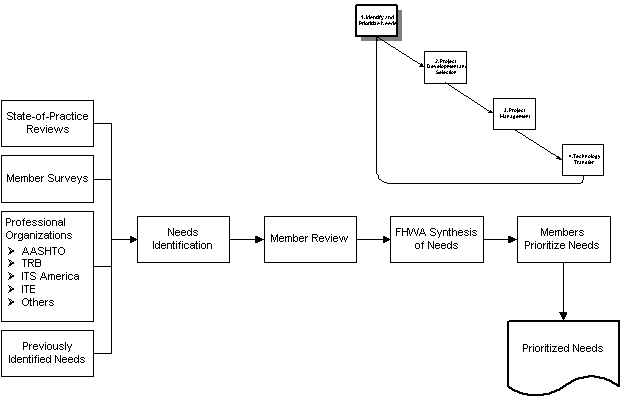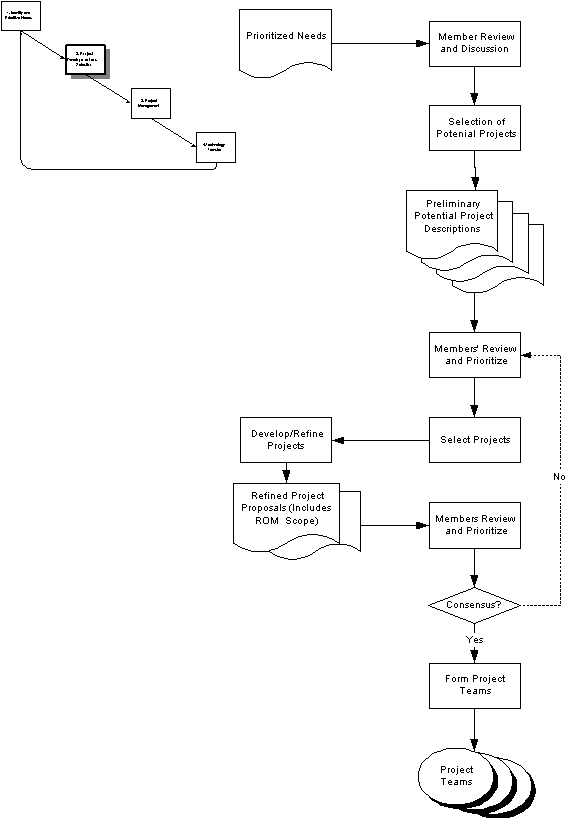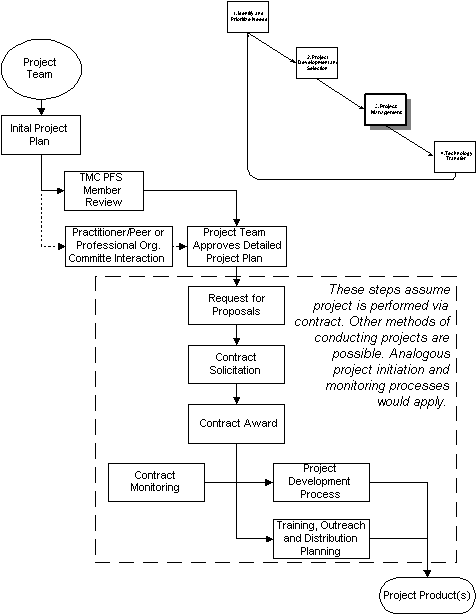Charter
Download the Printable Version (PDF 53KB)
PDF files can be viewed with the Acrobat® Reader®.
1. Guiding Principles
The goal of the TMC Pooled-Fund Study (PFS) is to assemble regional, state, and local transportation management agencies and the Federal Highway Administration (FHWA) to (1) identify human-centered and operational issues that are common among TMC operators and managers; (2) suggest approaches to addressing identified issues; (3) initiate and monitor projects intended to address identified issues; (4) disseminate results; and (5) assist in solution deployment.
2. Scope
The TMC Pooled-Fund Study is intended to serve as a forum for the participants[1] to identify and address human-centered and operational issues that are common among several transportation management centers. The TMC PFS will focus on issues that arise from transportation management centers that are part of traffic signal control systems, freeway management systems, or multi-modal systems. Within these broad topic areas, the following are offered as examples of issues that might be addressed within the intended scope:
- Operations planning and program issues.
- Operational strategies and plans.
- Operator procedures and task allocation.
- Operator-computer interfaces.
- System design and implementation.
- Facility and system performance monitoring, evaluation, and reporting.
- Contracting and procurement practices and issues.
- Transportation management and operations related to construction and maintenance work zones.
- System maintenance concepts and plans.
- Operator training.
- Personnel requirements and job descriptions.
- Personnel retention.
- Interagency cooperation and communication.
3. Projects
Ultimately, the purpose of the TMC Pooled-Fund Study is to initiate projects that address human-centered and operational issues associated with Transportation Management Centers. Projects may focus on conducting research, operational tests, technology transfer, or training. One key to the success of the TMC Pooled-Fund Study will be the identification and prioritization of projects that are of interest to the TMC PFS Members and the larger TMC community.
To ensure achievement of this objective, consensus will be the foremost criterion for project selection. The definition and selection of projects will be the product of consensus building. When all participants cannot agree on particular projects, project definition will focus on identification of a several projects that, taken as a whole, are of interest to all participants.
Figure 1 provides an overview of the life cycle of a TMC Pooled-Fund Study project. The four stages of a project life cycle are: (1) identify and prioritize needs, (2) project development and selection, (3) project management, and (4) technology transfer. Each of the stages in the life cycle of a project is discussed separately.

Figure 1. Overview of the life cycle of a TMC Pooled-Fund Study project.
3.1 Identify and Prioritize Needs
Figure 2 provides a simplified overview of the process to be used for to identify, and then prioritize, TMC human factors and operations research needs. FHWA will canvass Pooled-Fund Study members, the committees of various organizations, and review other related initiatives, current and past to identify critical TMC needs. The FHWA will synthesize the information compiled from this review and will prepare a brief synopsis that will be mailed to each TMC PFS participant.[2]
In addition to reviewing and commenting on the synopsis, the TMC PFS Members will prioritize the identified needs according to their perceptions and the needs of the organizations that they represent. The overall ratings of the participants will be summarized by FHWA for consideration by the participants in the next step of the life cycle, Project Development and Selection.

Figure 2. Process to identify and prioritize needs.
3.2 Project Development and Selection
Figure 3 illustrates the stage in which TMC PFS participants develop and select the project(s) to conduct. This stage will take place during a two-day annual meeting of the Members. Comments on the FHWA synopsis, and a summary of the synopsis will be presented at the meeting. A list of potential projects will be part of the synopsis. Members will be invited to make presentations at the meeting, and discussion following these presentations may result in revisions to the list of potential projects.
Following the discussion of issues, a selection and prioritization process will be undertaken. In this process, Members will rank order the projects. The highest-ranking issues will be marked for further development. The rankings will be subject to discussion and revision to encourage a consensus among Members. In particular, where diversity among Members appears to result in extreme differences in rankings (e.g., the highest priority issue of one group of participants is the lowest priority issue among another group), consensus-building techniques will be used to ensure that the perceived needs of all groups are accommodated.

Figure 3. Project prioritization and selection.
Those projects that appear to have the most support will be designated for further evaluation and development. Project groups may be formed, one for each of the designated projects. The project groups will prepare brief project summaries that includes the following information:
- Statement of the problem.
- Proposed approach
- A list of products to result from the project.
- Identification of users or customers of the products.
- Description of the implementation or results dissemination plan.
- Rough order of magnitude cost estimate that includes person hours and other charges.
- Other relevant recommendations, e.g.: preferred agency to manage project; contract mechanism; potential participants on project team; and other interests to provide feedback in the development of detailed project scope.
- Summary of in-kind support and proposed funding support from outside (not Pooled-Fund) sources.
- Approximate schedule for major milestones.
Each summary will be documented on a two-page form to be provided by FHWA. The summaries are intended to clearly state the purpose and products of the proposed projects, and to enable the Members to evaluate of the feasibility of completing the projects within available resources. After reviewing the project summaries, the Members will rank-order the projects in the same manner as in the initial prioritization. When more than one project is being considered for selection, this step can be used to assess which projects will best distribute Member interest across projects. Projected costs are compared to available resources.
Assuming that one or more projects can be performed within available resources, proposed projects will be put forward for the consensus support of the Members. Resource constraints or project support considerations may result in a re-prioritization of projects by the members. The final step in project selection is to form Project Teams for the projects selected for execution. These teams will assist in further development of projects, and provide high-level project oversight. The Members may choose to include involvement of practitioners, other peers, or professional organizations with the Project Teams to assist in developing projects.
3.3 Project Management
Figure 4 provides an overview of the project management stage. Following the meeting at which the Members select projects, the FHWA will prepare a detailed project plan for each project. The project plan(s) will include, budget, schedule with milestones, and a detailed description of the work to be performed. The project plans will be of sufficient detail to support issuance of a request for proposals or statement of work. The project plan(s) will be distributed to the Members for their review and comments. If the project team has identified other interested parties who are not Members, such as practitioners, or committees of professional organizations, the project plan will be submitted to those parties for their review, comment, or potential involvement.
The project team will review and comment on the plan, and resolve the outstanding issues before initiating the project. If a project requires a contract, then the project plan will be suitable for incorporation in a request for proposals and/or a statement of work. Contract Solicitations, when necessary, will be issued by the FHWA. The project team may elect members to participate in proposal review and contractor selection. Project committee members will be apprized of project progress relative to the project plan. Should substantial revisions to a project plan or contract be required after a project has commenced, all Members will be so advised. The project committee will participate in review of contract deliverables and provide advice to the Contracting Officer's Technical Representative.

Figure 4. Project management.
Prior to the end of a project, the project team will review the training, outreach, and distribution plan and modify it if necessary.
3.4 Technology Transfer
Figure 5 shows process for transfer of products and lessons learned to the greater TMC community. Transfer begins with a presentation of the final project product to the Members. The Members will decide on the disposition of products. Members may decide to follow the training, outreach, and distribution plan as proposed by the project team, or they may amend the plan. The Members may elect to initiate new projects based on the results of earlier projects. The implementation of this plan may involve the approval of subsequent projects to facilitate the desired technology transfer activities if the appropriate resources were not included in the original project plan.

Figure 5. Technology transfer process.
4. Governance
This Charter provides rules that govern: TMC Pooled-Fund Study membership; project selection; project management, coordination, and solicitation; policies and procedures; fiscal management; and overall TMC Pooled-Fund Study management. Because the charter may require updates as new issues are identified and resolved by the members, provision for revision of the charter is provide in section 4.7, Amendments.
4.1 Membership
Membership shall consist of technical representative chosen by the respective participant states[3] and the FHWA[4].
Given that the goal of the TMC Pooled-Fund Study "…is to assemble regional, state and local traffic management agencies …" the processes associated with identifying and developing projects should provide a mechanism to encourage interaction with other TMC interests that reaches beyond the Members. In facilitating of Pooled Fund Study activities, FHWA will work with members to explore opportunities to integrate the feedback and insight of these other TMC interests.Participation of other interests will focus on integrating the technical expertise and experience of individuals or those who may be representing organizations that have an interest in TMC's. These individuals might include practitioners that manage TMC's, regardless of whether their agencies are Members of the Pooled Fund Study. Expertise may be sought from representatives of TMC related committees of professional organizations. Ongoing outreach and awareness of Pooled Fund Study activities is expected to occur with the various TMC related committees of the Transportation Research Board, ITS America, AASHTO, and the Institute of Traffic Engineers (ITE). An example of one group that could be considered is the ITE TMC Committee. The Members will define the specifics of participation by these interests.
4.2 Voting Privileges
Consensus decision making will be the goal in all TMC PFS activities.
It is recognized that the Members have different backgrounds, needs, and experiences in TMC management and operations. Because of these diverse backgrounds and interests, there will be differences project prioritization. A consensus building process, will recognize these differences and is expected to arrive at a group of projects that, taken together, will reflect the interests of all Members. As the number of participants and resources that are committed to the TMC PFS grow, so too will the number and diversity of projects. Project selection will recognize the diversity of the membership.
In general, formal votes will be avoided. The Chair will work with the Members to develop consensus decisions. Consensus decisions require agreement among the assembled members and require the presence of at least three-fourths of the members. Absent a quorum of three-fourths of the members, members not present will be consulted for their agreement. Should a vote be necessary, a two-thirds majority of the assembled participants will decide votes. A quorum of three-fourths of the Members is required for either votes or consensus decisions. When a quorum is not assembled, the non-present members shall be polled, typically by e-mail, and decisions delayed until all members have responded, or until all members have had sufficient opportunity to respond.
4.3 Policies and Procedures
The Members will adopt polices and procedures as they deem appropriate, and shall select a Chair and Co-chair. The rules contained in the current edition of Robert's Rules of Order Newly Revised shall govern the TMC Pooled-Fund Study in all cases to which they are applicable and in which they are not inconsistent with these bylaws and any special rules of order the TMC Pooled-Fund Study may adopt.
4.4 Funding
Pooled funding will be derived from contributions received from participating entities.
4.5 Appointments
The Members are responsible for creating and terminating various project teams or other organizational units as required to meet project requirements.
4.6 Budget and Work Plans
The Members will approve project budgets and work plans.
4.7 Amendments
Amendments to the Charter shall be by four-fifths vote of the voting membership. Any member may propose amendments. A Quorum (three-fourths of members) must be present for a vote of the membership. In the event that a Quorum is not present, then the Members shall be polled[5].
5. Program Administration
As part of its contribution to the TMC PFS, the FHWA Office of Research, Development, and Technology will serve as Program Administrator and administer TMC Pooled-Fund Study resources under the direction of the Members.
5.1 General Support
Under direction of the Members, or a project team delegated by the Members, the Program Administrator will draft Requests for Proposals (RFPs) and coordinate the proposal review process. The participants, or their delegated project team, shall approve membership on committees that review RFPs or otherwise selecting consultants to perform TMC Pooled-Fund Study projects.
5.2 Contract Administration
The Program Administrator will distribute RFPs, prepare contract documents, and perform other functions related to contract administration and management. Under direction of the participants or their delegated project committee, the Program Administrator will ensure that contracts, schedules, work plans, and project descriptions are followed. The Program Administrator will be responsible for day-to-day quality control and evaluation, recommendations regarding preparation of contract documents, change order requests, and authorization of progress payments. The Program Administrator is responsible for providing contract progress reports to the participants or their delegated project committee. The Program Administrator will distribute project progress reports to the participants at least quarterly, and will respond to participant comments or inquiries regarding progress reports within 30 days of receipt.
5.3 Management Budget
The Program Administrator is responsible for administering a management budget that may include travel and per diem payments for active participants or their designated representatives. Per diem and travel shall be administered in a manner consistent with the prevailing per diem and travel policies of the participating entity to which the traveler belongs.
6. Program Members
For the purposes of charter ratification, membership shall consist of the FHWA and state/districts that have committed funding to the TMC Pooled Fund Study. Additional states may become participants by committing funds at a level deemed appropriate by the participants. Additional entities that seek to contribute to the fund and become members, such as toll authorities or others associated with the operation of surface transportation control centers, will be considered for membership by the members on a case-by-case basis.
